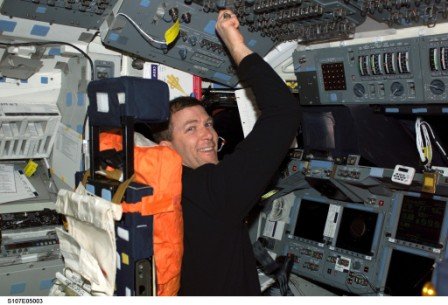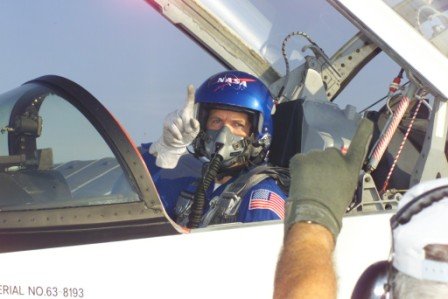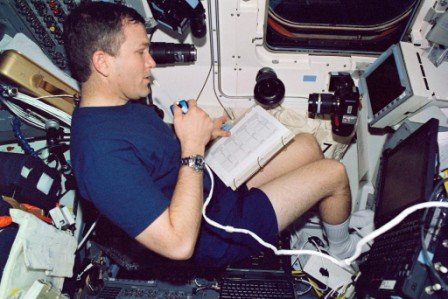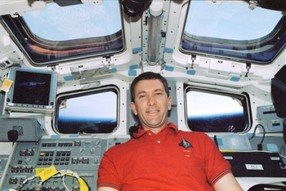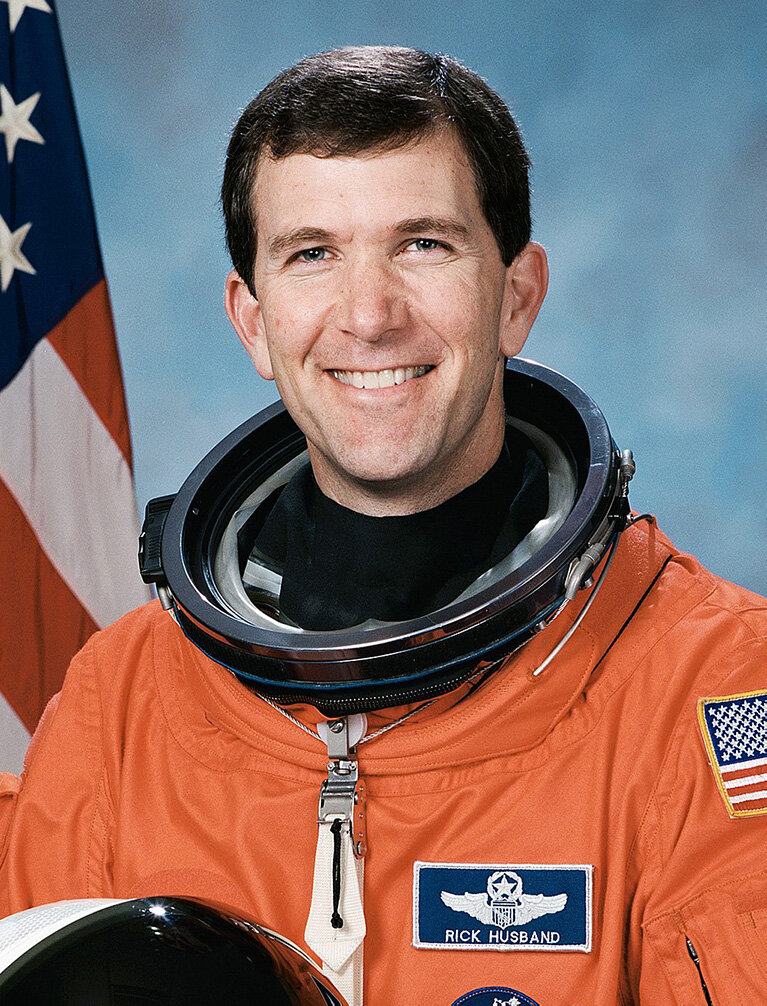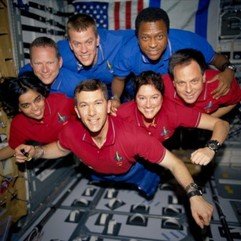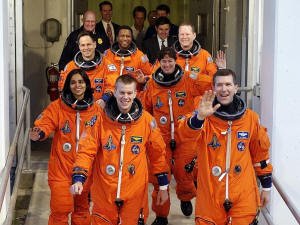Rick D. Husband
Early life, education and training
Husband was born on July 12, 1957, in Amarillo, Texas.[1] At the age of 17, he earned his pilot's license while flying out of Tradewind Airport. Husband graduated with honors from Amarillo High School in 1975.
Husband earned a Bachelor of Science degree in mechanical engineering from Texas Tech University in 1980 after five years of study. Upon graduation, he was commissioned as a pilot in the United States Air Force, having been enrolled in ROTC his last two years of college. Husband underwent pilot training at Vance Air Force Base, in Enid, Oklahoma. This was followed by Land Survival School at Fairchild Air Force Base, in Spokane, Washington, and Fighter Lead-in School in New Mexico. After he got married on February 27, 1982, Husband trained in the F-4 at Homestead Air Force Base next.[2]
U.S. Air Force career
Husband was assigned to a squadron at Moody Air Force Base in Valdosta, Georgia flying the F-4E. Rick then transferred to George AFB, in Victorville, California in December 1985, where he became an F-4 instructor. By then he had accumulated 1000 hours of flying time.[2]: 30, 32
In December 1987, Husband was assigned to Edwards Air Force Base in California, where he attended the USAF Test Pilot School class 88A along with future Canadian Space Agency astronaut Chris Hadfield. Upon completion of test pilot school, Husband served as a test pilot flying the F-4 and all five models of the F-15 Eagle. In the F-15 Combined Test Force, he was the program manager for the Pratt & Whitney F100-PW-229 increased performance engine, and also served as the F-15 Aerial Demonstration Pilot.
In June 1992, Husband was assigned to the Aircraft and Armament Evaluation Establishment at Boscombe Down, England, as an exchange test pilot with the Royal Air Force. At Boscombe Down, he was the Tornado GR1 and GR4 Project Pilot and served as a test pilot in the Hawk, Hunter, Buccaneer, Jet Provost, Tucano, and Harvard.
Husband logged over 3,800 hours of flight time in more than 40 different types of aircraft.[1]
NASA career
Husband was selected as an astronaut candidate by NASA in December 1994, the same week he was promoted to lieutenant colonel.[2]: 67 Husband reported to the Johnson Space Center in March 1995 to begin a year of training and evaluation. Upon completion of training, he was named the Astronaut Office representative for Advanced Projects at Johnson Space Center, working on Space Shuttle Upgrades, the Crew Return Vehicle (CRV) and studies to return to the Moon and travel to Mars. Husband eventually served as Chief of Safety for the Astronaut Office. He flew as pilot on STS-96 in 1999, and logged 235 hours and 13 minutes in space. Husband was later assigned to command the crew of STS-107, which was launched early in 2003. Along with the rest of the STS-107 crew, Husband was killed upon reentry when the shuttle exploded over Texas.
Shuttle missions
STS-96 (May 27 to June 6, 1999) aboard the Space Shuttle Discovery was a 10-day mission during which the crew performed the first docking with the International Space Station and delivered four tons of logistics and supplies in preparation for the arrival of the first crew to live on the station early the following year. The mission was accomplished in 153 Earth orbits, traveling 4 million miles in 9 days, 19 hours and 13 minutes.
STS-107 (January 16 to February 1, 2003) aboard the Space Shuttle Columbia was a 16-day mission during which the crew performed over 80 experiments testing applications of microgravity to gain insight into the environment of space and improve life on Earth as well as enable future space exploration. The mission ended on the morning of February 1 when the shuttle disintegrated upon reentry killing all crew members, including Husband (see Space Shuttle Columbia disaster).
Awards and decorations
US Air Force Command Astronaut Badge
Defense Distinguished Service Medal (posthumous) Meritorious Service Medal with two bronze oak leaf clusters Aerial Achievement Medal Air Force Commendation Medal Congressional Space Medal of Honor (posthumous) NASA Distinguished Service Medal (posthumous) NASA Space Flight Medal (posthumous) National Defense Service Medal Air Force Longevity Service Award with two oak leaf clusters Air Force Training Ribbon
Tributes
Husband Hall, in the Columbia Village apartments, at the Florida Institute of Technology.
Husband Mission, one of the projects in the educational SpaceLab Program,[4] run by the Ramon Foundation in memory of Ilan Ramon. Involves the writing of new Wikipedia entries on a variety of space and STEM related topics.
Husband Hill, one of the Columbia Hills on Mars.
Asteroid 51823 Rickhusband.
Rick Husband Amarillo International Airport, in his hometown of Amarillo, Texas.
Husband Auditorium, Squadron Officer School building, Maxwell AFB, Alabama.
Rick Husband Drive, El Paso, Texas.
Husband-Boeing Engineering Honors Program at California State University, Fresno
S.S. Rick Husband, the Cygnus CRS OA-6 uncrewed resupply spacecraft.[5]
The lunar crater Husband is named after Husband.[6]
Quotes
Husband describes how he became a shuttle commander having flown in only one other space flight:
"I was just at the right place at the right time."[2]: 105
Rick Husband before his first flight:
"It [space] was just so incredibly adventurous and exciting to me. I just thought there was no doubt in my mind that is what I want to do when I grow up."
Husband was also well known for his faith, and in the last-request forms that astronauts fill out before every flight, he left his pastor a personal note:
Personal life
Husband's wife, Evelyn (born September 18, 1958), details her Christian life with Rick and his struggles to fulfill his lifelong dream to become an astronaut in the 2004 book High Calling: The Courageous Life and Faith of Space Shuttle Columbia Commander Rick Husband co-written with Donna VanLiere. The Husbands have two children: a daughter, Laura Marie (born October 5, 1990), and a son, Matthew (born August 3, 1995). Evelyn married Bill Thompson in January 2008 and was the keynote speaker for the memorial ceremony at the Astronaut Memorial "Space Mirror" at the Kennedy Space Center in Florida, five years after the Space Shuttle Columbia tragedy.[8]
About Space Shuttle Columbia
Space Shuttle Columbia (OV-102) was a Space Shuttle orbiter manufactured by Rockwell International and operated by NASA. Named after the first American ship to circumnavigate the upper North American Pacific coast and the female personification of the United States, Columbia was the first of five Space Shuttle orbiters to fly in space, debuting the Space Shuttle launch vehicle on its maiden flight in April 1981. As only the second full-scale orbiter to be manufactured after the Approach and Landing Test vehicle Enterprise, Columbia retained unique features indicative of its experimental design compared to later orbiters, such as test instrumentation and distinctive black chines. In addition to a heavier fuselage and the retention of an internal airlock throughout its lifetime, these made Columbia the heaviest of the five spacefaring orbiters; around 1,000 kilograms (2,200 pounds) heavier than Challenger and 3,600 kilograms (7,900 pounds) heavier than Endeavour. Columbia also carried ejection seats based on those from the SR-71 during its first six flights until 1983, and from 1986 onwards carried an imaging pod on its vertical stabilizer.
During its 22 years of operation, Columbia was flown on 28 missions in the Space Shuttle program, spending over 300 days in space and completing over 4,000 orbits around Earth. While it was seldom used after completing its objective of testing the Space Shuttle system, and its heavier mass and internal airlock made it less than ideal for planned Shuttle-Centaur launches and dockings with space stations, it nonetheless proved useful as a workhorse for scientific research in orbit following the loss of Challenger in 1986. Columbia was used for eleven of the fifteen flights of Spacelab laboratories, all four United States Microgravity Payload missions, and the only flight of Spacehab's Research Double Module. The Extended Duration Orbiter pallet was used by the orbiter in thirteen of the pallet's fourteen flights, which aided lengthy stays in orbit for scientific and technological research missions. Columbia was also used to retrieve the Long Duration Exposure Facility and deploy the Chandra observatory, and also carried into space the first female commander of an American spaceflight mission, the first ESA astronaut, the first female astronaut of Indian origin, and the first Israeli astronaut.
At the end of its final flight in February 2003, Columbia disintegrated upon reentry, killing the seven-member crew of STS-107 and destroying most of the scientific payloads aboard. The Columbia Accident Investigation Board convened shortly afterwards concluded that damage sustained to the orbiter's left wing during the launch of STS-107 fatally compromised the vehicle's thermal protection system. The loss of Columbia and its crew led to a refocusing of NASA's human exploration programs and led to the establishment of the Constellation program in 2005 and the eventual retirement of the Space Shuttle program in 2011. Numerous memorials and dedications were made to honor the crew following the disaster; the Columbia Memorial Space Center was opened as a national memorial for the accident, and the Columbia Hills in Mars' Gusev crater, which the Spirit rover explored, were named after the crew. The majority of Columbia's recovered remains are stored at the Kennedy Space Center's Vehicle Assembly Building, though some pieces are on public display at the nearby Visitor Complex.

